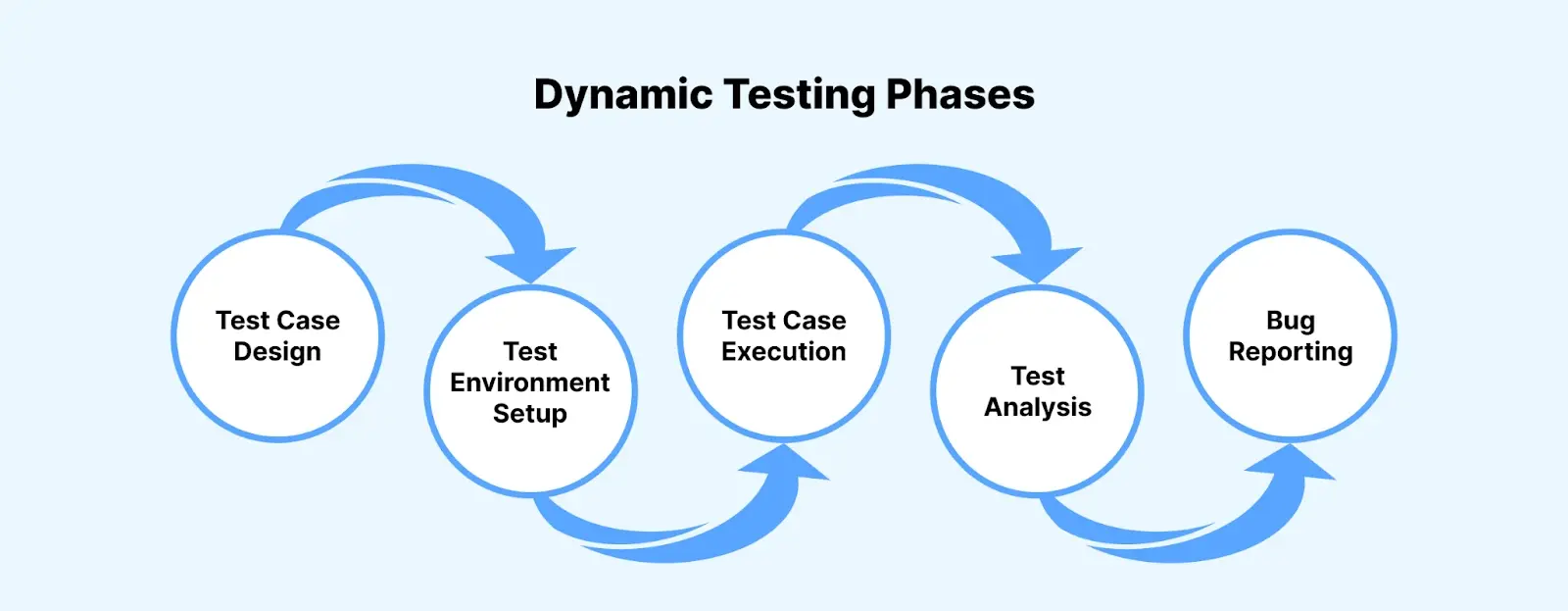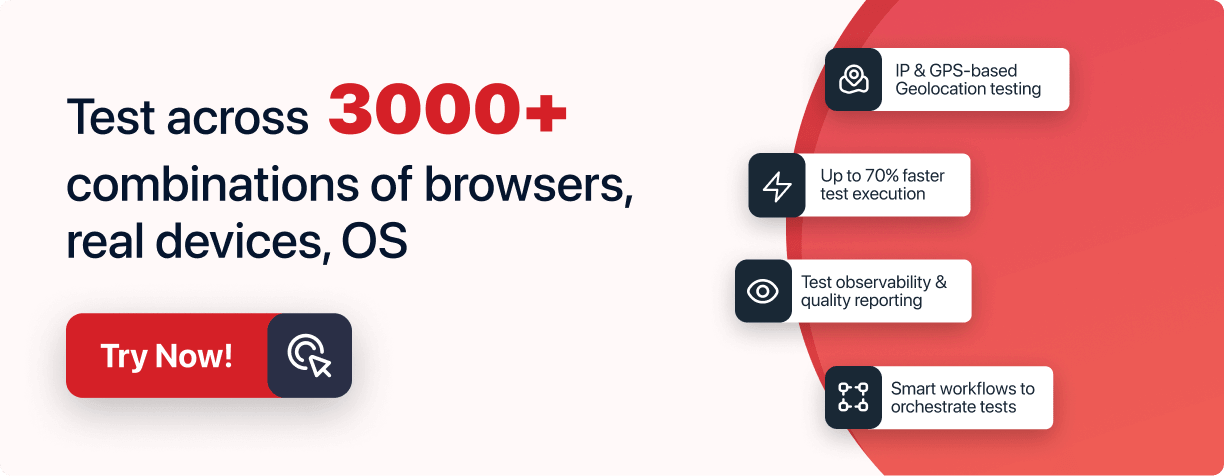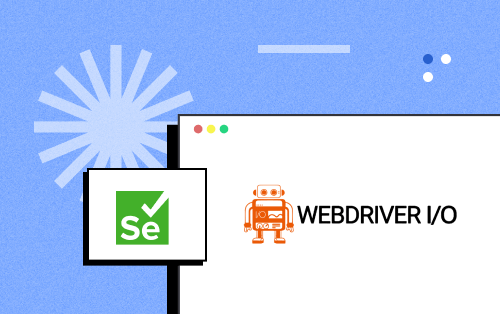- Automation
- Home
- /
- Learning Hub
- /
- Dynamic Testing Tutorial
- -
- June 13 2023
What is Dynamic Testing? Types, Methodologies, and Examples
Dynamic testing evaluates software by executing code to identify defects, ensuring functionality, and verifying system performance. Learn what is dynamic testing, its types, phases, and more.
OVERVIEW
Dynamic testing is a crucial method in software quality assurance, focusing on analyzing a program's dynamic behavior. This approach involves inputting data and evaluating the output against expected results by executing test cases. These tests can be conducted either manually or via automated processes. The software code must be compiled and executed for dynamic testing to be effective, ensuring comprehensive assessment and validation of the software's functionality and performance.
In today's rapidly advancing software development landscape, where agility and responsiveness are paramount, traditional testing approaches often struggle to meet the growing demands for speed, efficiency, and quality.
As software applications become more complex and interconnected, static testing methods alone prove insufficient in ensuring the reliability and performance of applications. Consequently, dynamic testing has emerged as a robust methodology, offering organizations the means to uncover critical defects and optimize their software applications effectively.
Traditional testing methods, such as manual code reviews and static analysis, are significant Software Development Life Cycle (SDLC) components. While they play a crucial role in identifying syntactical errors, logical flaws, and potential vulnerabilities, they cannot fully assess the software's behavior and performance in real-world scenarios.
Static testing, by its nature, scrutinizes the code without executing it, limiting its scope to identifying issues at the code level. On the other hand, dynamic tests actively exercise the software during runtime, allowing for a comprehensive evaluation of its functionality, responsiveness, and robustness.
What is Dynamic Testing?
Dynamic testing is defined as the test involving analysis of the dynamic behavior of code in the software application. In this test process, it is crucial to provide input and output values as per the expectation while running a test case. This test case can be run both by manual and automation approaches. It’s also important to compile and run the software code for this.
This approach provides valuable insights into how the application handles different scenarios and reveals potential weaknesses that may go unnoticed during static testing.
Dynamic tests align seamlessly with Agile development methodologies. Agile approaches emphasize iterative development and frequent releases to respond quickly to changing requirements and market demands. Dynamic tests provide Agile teams with rapid feedback on the software's behavior, allowing them to iterate and make necessary adjustments promptly.
By integrating dynamic testing into their development processes, organizations can foster a culture of continuous improvement, ensuring that each iteration delivers high-quality software while maintaining agility and speed.
One of the key benefits of dynamic tests lies in their ability to uncover defects and issues that may remain undetected through static analysis alone. By examining the software in action, testers can identify runtime errors, memory leaks, performance bottlenecks, security vulnerabilities, and other critical flaws that impact the software's functionality and user experience.
This proactive approach allows developers to address these issues early in the development cycle, reducing the risk of costly and time-consuming fixes at later stages.
Why Dynamic Testing?
The dynamic test is performed to ensure the accurate working of the software applications during and after their installation. With this, you can ensure that the software application is free from any bugs and error-free. In other words, the dynamic test assures the software application's overall functionality and performance. Additionally, it also ensures that software applications are stable and consistent.
To illustrate the significance of consistency in dynamic testing, let's consider an example related to a banking application. This application includes various screens such as "My Accounts," "Funds Transfer," and "Bill Pay," each containing an amount field that accepts numeric characters.
Now, assume that the "My Accounts" screen displays the amount as "10,000," while the "Funds Transfer" screen shows it as "$10,000," and the "Bill Pay" screen simply displays "$10000." Although the amount value remains the same, the inconsistent display of the amount across different screens creates confusion and undermines the software's overall consistency.
Consistency in dynamic tests is not limited to just functional aspects. It also encompasses standards such as performance, usability, compatibility, and more. Therefore, conducting dynamic tests becomes crucial to ensure that the software adheres to these various aspects of consistency.
Characteristics of Dynamic Testing
To better understand the fundamentals and concepts of dynamic testing, it is important to learn about its characteristics. Here are some of them:
- In the dynamic test process, the running and testing of software applications are done against a set of predefined test cases.
- You should first identify the feature which requires it to be tested. Following this, you must execute the test case in a test environment. It is important to prepare the test case in the early stage of dynamic testing.
- Running the code with necessary input according to end-user specifications is important.
- You are required to analyze the real output post-test execution and compare them to the expected output. The output you get helps in deciding the behavior and functionality of the software application. In case of compliance, the test will pass; otherwise, the test will fail.
- It is more of a formal testing approach for various testing actions like test execution, coverage consideration, reporting, and test case identification.
Benefits of Dynamic Testing
Dynamic tests are an essential part of the Software Testing Life Cycle (STLC) as it allows for assessing the behavior and performance of a software application during runtime. This involves executing the software application and observing its behavior in a real or simulated environment.
Here are some benefits of running dynamic tests
- Dynamic testing verifies that the software functions correctly and as intended. It ensures critical functionalities work without errors by executing the application and interacting with its various features.
- It helps in evaluating the efficiency of the software application. You can measure the application's responsiveness, speed, and resource consumption during execution.
- By analyzing the software's behavior under different conditions, It identifies performance errors or issues that may impact its reliability and user experience.
- You can assess software application behavior in different hardware and network configurations and evaluate its capability to handle concurrency and workload demands.
- Dynamic tests enable the evaluation of the software's resilience and robustness under various stresses, such as network disruptions or hardware failures. We can identify its behavior and performance in challenging scenarios by subjecting the software to these stress conditions.
Type of Dynamic Testing
You can run dynamic tests when the code is executed in the run-time environment. This process is a type of validation approach where functional and non-functional tests are performed. These are the primary type of dynamic tests explained below:
Functional Testing
Functional testing focuses on the software application specification to ensure functionality and performance. It tests the developed features of software applications to check whether they function as per the requirement specification.
The functional test is performed by executing the test case written by the Quality Assurance (QA) team. In the phase functional test, each module of software applications is tested by providing inputs and verifying the related output.
The analysis of the actual result from the software applications is then compared with the expected results. Such comparison is helpful as it determines whether the software application functions correctly and gives the desired result.
Thus, we can say that this process helps identify any deviations or discrepancies between the system's behavior and the specified functional requirements. Further, functional testing is divided into the following types:
- Unit Testing: It focuses on individual components or modules, verifying their functionality in isolation. This helps in determining that every component and unit is working independently.
- Integration Testing: It examines the interaction between different software application components to ensure seamless collaboration. You can test how components work and interact together.
- System Testing: It validates the entire software system, including its integrations with external systems or dependencies. System testing involves testing all components and modules of software applications to ensure they meet business requirements.
- Acceptance Testing: It ensures that the software meets the specified requirements and satisfies the end-users needs. You have to perform this test just before the release of the software application to ensure it performs optimally in real-user conditions.
Non-Functional Testing
Non-functional testing involves checking and verifying the quality of the software applications by addressing their non-functional aspects. Such tests are associated with evaluating the alignment of the working and quality of the software application with Software Requirement Specifications (SRS).
It involves testing factors like usability, effectiveness, maintainability, and performance. Non-functional testing ensures the software performs well in attributes other than its basic functionality. These attributes may include the software's ability to handle large amounts of data, its response time, stability under stress or load conditions, security measures, and compatibility with different platforms or environments.
By performing non-functional tests, you can lower the production risk related to non-functional aspects of software applications. With this, errors like memory leaks, performance, or system robustness can be easily identified and fixed before software release in the market.
Non-functional testing is performed throughout various stages of the testing process, covering all test levels. Its purpose is to ensure that the software meets the functional requirements, provides a satisfactory user experience, and exhibits desirable non-functional characteristics.
The non-functional test is divided into different types, which can be performed to ensure the quality of the software application.
- Performance Testing
- It is a crucial type of non-functional testing that analyzes the behavior and working of the software application under particular conditions or loads.
- Performance testing is needed when the software applications are stabilized and moved to production, where different users will do it simultaneously.
- Common performance testing techniques include load testing, stress testing, endurance testing, and spike testing, each designed to assess different aspects of the application's performance under specific conditions.
- Performance testing results provide valuable insights and help stakeholders make informed decisions about system improvements, optimizations, and capacity planning.
- Usability Testing
- It is a type of testing that focuses on evaluating the user-friendliness, efficiency, and accuracy of a software application from the perspective of end users.
- Assesses how well the application meets user expectations, how intuitive its user interface is, and how effectively users can interact with its features and functions.
- Helps identify usability issues, such as complex navigation, unclear instructions, lack of consistency in design elements, or cumbersome workflows that may hinder user productivity or satisfaction.
- Ensures that the software application is user-centric and meets the needs and expectations of the target audience. It helps uncover potential usability problems early in development, reducing the risk of negative user experiences and the need for costly redesign or rework.
- Consider factors such as ease of learning, efficiency of use, error prevention, user satisfaction, and accessibility to ensure a positive and effective user interaction with the software.
- Compatibility Testing
- Compatibility testing is a type of non-functional testing that focuses on checking the functionality and behavior of an application across different software, hardware platforms, networks, and browsers.
- It is particularly important for applications where the organization does not have control over the platforms used by end users, such as web-based applications accessed from different browsers or mobile apps used on various devices.
- It involves testing the application on different operating systems, versions, devices, browsers, and network setups to verify its compatibility and identify any issues or limitations.
- It may involve testing for backward compatibility (ensuring the application works with older versions) or forward compatibility (ensuring the application remains functional with future versions or technologies).
- Recovery Testing
- It involves verification of the working of the software application by analyzing how well it recovers from hardware failures and crashes.
- It involves deliberately inducing failures or simulating critical scenarios in a controlled environment to observe the system's response and recovery mechanisms.
- Recovery testing helps assess the system's fault tolerance, resilience, and ability to recover without losing data or compromising its functionality.
- It is important for critical systems or applications where downtimes or data loss, such as financial, healthcare, or emergency response systems, can have significant consequences.
- Recovery testing validates the system's recovery procedures, such as backup and restore mechanisms, failover capabilities, redundancy measures, and data integrity checks.
- Security Testing
- It focuses on identifying a software application's weaknesses, risks, and threats to ensure its security and protect it from potential attacks or breaches.
- Finds vulnerabilities and potential points of exploitation in the application's design, implementation, or configuration so that the software does not stop working.
- Security testing involves simulating various attack scenarios, such as penetration testing, vulnerability scanning, or ethical hacking, to assess the application's resilience against potential threats.
- It may also involve compliance testing to ensure the application adheres to specific security standards, regulations, or industry best practices.
Dynamic Testing Methods
As we have learned about dynamic testing and its type, which aims to assess the functionality and behavior of the software application, it is important to know the different methods involved in this process.
This will help you understand the approaches through which dynamic tests are performed. The main dynamic testing methods are black box, white box, and grey box testing. Let us learn about these in detail:
Black Box Testing
Black box testing involves validating the software application without knowing its internal structure, code, and design. It aims to verify the function of software applications under test and execute the entire test suite without programming knowledge. Here, the test is performed according to the requirements and specifications.
In this method, the testers treat the software as black box and emphasize its outputs and inputs. The different test scenarios are considered when it is performed, and related test cases are executed to test the software application’s response. Hence, you can say that software applications are assessed according to the end-user perspective without any idea of their internal structure.
White Box Testing
White box testing, or clear box or structural testing, involves examining the software's internal structure and code. This mandates know-how of coding as it requires testing the internal code implementation and algorithms of the software applications. The tester has access to the underlying code and uses this knowledge to design test cases that target specific code paths, logic branches, and conditions.
In this testing method, you have to execute the programming line-by-line to detect any related errors. Hence, it is done to fulfill its aim of checking how software applications perform based on the code.
Grey Box Testing
Grey box testing is a combination of black box and white box testing. In grey box testing, the tester has partial knowledge of the internal workings of the software. This may include access to system documentation, database schemas, or a limited understanding of the code. Based on this partial knowledge, test cases are designed to evaluate the software's behavior and functionality.
It allows for a more comprehensive testing approach, combining black box and white box testing elements. It helps identify defects that may arise due to interactions between different system components or modules.
Dynamic Test Tools
When you talk about performing or executing dynamic tests, various automation testing tools are available that quicken and scale the test process. Here are some commonly used tools to run dynamic tests.
- LambdaTest
- Selenium
- Appium
- TestComplete
LambdaTest is an AI-powered test orchestration and execution platform that allows you to perform dynamic testing at scale with over 3000+ real devices, browsers, and OS combinations. It is easy to validate the behavior and performance of the software application under different test conditions.
Its real device cloud infrastructure offers over 3000 real device-browser-OS combinations for dynamic testing. Whether you have a web or mobile app, you can choose between manual or automated dynamic tests using LambdaTest on a wide range of real devices and browsers.
Subscribe to the LambdaTest YouTube Channel and stay up to date with the latest tutorials around Selenium testing, Cypress testing, and more.
LambdaTest seamlessly integrates with your testing needs and provides multiple solutions for both manual and automated testing requirements. With LambdaTest, you can ensure thorough and efficient software application testing across various platforms and environments.
Selenium helps in dynamic testing by providing a robust framework for automating web browsers. It allows developers and testers to interact with web elements, simulate user actions, and verify dynamic behavior.
With Selenium, you can dynamically wait for elements to appear, handle AJAX calls, validate dynamic content updates, and perform real-time data-driven testing. This enables efficient and reliable testing of dynamic web applications by replicating user interactions and verifying the expected behavior under various scenarios.
Appium aids in dynamic testing by providing a cross-platform mobile automation framework for mobile app testing. It allows testers to automate interactions with mobile applications, including gestures, taps, swipes, and more.
With Appium, you can dynamically wait for elements to be visible, handle asynchronous events, validate dynamic content updates, and perform real-time data-driven testing on mobile devices. This enables efficient and reliable testing of dynamic mobile applications, ensuring their responsiveness and functionality under various conditions and user interactions.
TestComplete helps dynamic testing by providing a robust platform for web, mobile, and desktop applications. It allows testers to interact with the elements, mimic user actions and verify the dynamic function or behavior of the software application across different platforms and technologies.
TestComplete offers features like object recognition, synchronization mechanism, and data-driven testing to manage dynamic elements. With this, you can ensure the accuracy and responsiveness of the dynamic applications that help in reliable testing in different test scenarios.
Process Of Dynamic Testing
Dynamic testing in the Software Testing Life Cycle (STLC) involves several important phases. These phases include requirements analysis, test planning, test case design and implementation, test environment setup, test case execution, bug reporting, and test closure.
Each phase in a dynamic test relies on completing the previous task in the testing process. This sequential flow ensures the necessary groundwork is done before moving on to the next step.

In the STLC, we can consider the actual dynamic test process to begin with creating the test case design. This is where the test cases are created, specifying the inputs, expected outputs, and steps to be executed.
Let's take a closer look at each activity within the dynamic test process to understand their significance and how they contribute to ensuring the quality of the software application. However, before digging into the phase, let us first understand the process that needs to be followed before dynamic testing.
The first step is establishing a test strategy, which primarily focuses on the available resources and the timeframe allocated for testing. Considering these factors, the objective of the testing, the scope of testing, the phases or iterations of testing, the type of environment, assumptions or challenges that may be encountered, risks, and other relevant details need to be documented. When it is done, the test process moves toward designing a test case, as explained below.
- Test Case Design
- Test Environment Setup
- Test Case Execution
- Test Analysis
- Bug Reporting
Test design and implementation are crucial phases in the dynamic test process. It involves identifying the features to be tested and deriving the necessary test conditions, coverage items, and test cases. During this phase, the testing team analyzes the software requirements to determine which features must be tested. They then derive test conditions, specific scenarios, or situations that must be tested.
The team also identifies coverage items, which are the specific aspects or components of the software to be tested. This ensures comprehensive coverage of critical areas. The team derives test cases based on the test conditions and coverage items. Test cases consist of inputs, steps, and expected outcomes. They serve as a roadmap for executing tests and validating the software's behavior.
Following designing the test case, you have to prepare the test environment that mimics the production environment. It is important to ensure that when the software application is developed, its testing must be performed on the software product. Its main purpose is to install the test environment that helps to align the compatibility of the software application being tested.
When the test environment is installed, next, you have to execute test cases prepared in the primary stage of the dynamic test process. Here, you have to run the test case and observe the behavior of the software application under diverse scenarios and inputs.
After executing the test cases, the outcomes and results are analyzed and evaluated. This step involves comparing the actual results obtained during the test execution with the expected results.
If there are any discrepancies or differences between the expected and actual results, it indicates a potential issue or bug. Such cases are considered test failures, and the identified bugs or defects are logged in the bug repository for further investigation and resolution.
After the test analysis and execution, the next stage is to report bugs between the actual and expected results. The bugs are reported to the developers so that it is fixed before the software applications are released to the market. This helps them to find any other related issues and works to resolve them to ensure the quality of the software applications.
Example of Dynamic Testing
Now that you know about the dynamic test and its features to get a clear idea, let’s explain this with an example.
Imagine we are testing a Login Page that consists of two fields: "Username" and "Password." Now, let's focus on the "Username" field, which is supposed to accept only alphanumeric characters.
During dynamic testing, we interact with the actual system by providing inputs and observing how the application responds. In this case, if we enter "XYZ" as the Username, the system accepts it without any issues. However, the application throws an error message if we enter "XYZ@123" as the Username. This outcome demonstrates that the code dynamically reacts to user input, enforcing the restriction on accepting only alphanumeric characters.
In dynamic tests, the goal is to work with the system as an end user, purposely looking for errors or unexpected behavior. We simulate real-world usage scenarios, input various data, and compare the actual behavior of the application to the expected behavior. This allows us to identify any discrepancies, inconsistencies, or bugs that may arise during runtime.
Dynamic tests validate software applications in different environments, replicating the conditions under which end users would operate the software. By conducting dynamic testing, we ensure the software functions correctly, provides accurate responses, and delivers the intended user experience.
In a nutshell, dynamic tests are an essential process that helps us build reliable and user-friendly software. It allows us to uncover issues that might not be apparent through other testing approaches, ensuring that the application performs as expected and meets the end user's needs.
Difference between Static and Dynamic Testing
Static and dynamic testing are two fundamental approaches used in software testing. Here are the key differences between them.
| Static Testing | Dynamic Testing |
|---|---|
| Focuses on validating the code or documentation. | Focuses on executing the software application. |
| Performed without executing the code. | Performed by running the code and observing behavior. |
| Examples include code reviews, inspections, and walkthroughs. | Examples include functional testing and performance testing. |
| Detects defects without the need for code execution. | Detects defects through code execution and observation. |
| It can be conducted at any stage of the Software Development Life Cycle. | Typically performed during later stages of the Software Development Life Cycle. |
| Identifies issues related to code structure, syntax, and standards. | Identifies issues related to functionality, performance, and usability. |
| Requires manual analysis by testers or reviewers. | Involves automated or manual test case execution. |
| Less time-consuming compared to dynamic testing. | More time-consuming due to code execution and analysis. |
| Does not require a running application or system. | Requires a running application or system for testing. |
Advantages of Dynamic Testing
Dynamic testing holds several advantages in testing and checking the functionality of the software application. Let us learn some of those:
- It includes non-functional testing, which helps evaluate the system's performance. It assesses factors like software application response, speed, stress handling, and loading time under real user conditions. This helps identify performance issues and areas for improvement.
- By preparing test cases early in the testing life cycle and executing them, dynamic testing helps identify defects at an early stage. This saves time by addressing issues promptly and preventing their propagation to later stages.
- It verifies the correct functioning of major system functionalities and ensures proper communication between different modules. This enhances the quality of the software and instills confidence in its performance.
- Dynamic tests validate whether the software meets specified requirements and functional specifications. Executing test cases and comparing the actual behavior with expected results ensures the software aligns with the intended functionality.
Disadvantages of Dynamic Testing
Dynamic testing is not an exception, as it has some disadvantages. You must be aware of those so that any future issues in the test process can be addressed and fixed. Here are some of its disadvantages:
- Dynamic tests often occur later in the Software Development life Cycle. Any issues or defects identified during this stage may require significant effort and resources to fix.
- It is a time-consuming process, including the execution of the application, software, and code, that involves a significant amount of resources.
- It is a valuable process, but it is less effective than static testing in some situations. For example, in static testing, activities like code reviews and inspections can detect certain defects which may go unnoticed in dynamic tests.
- It might not be possible to cover all test scenarios through dynamic testing alone.
- It is challenging to pinpoint the exact root cause of the software applications with dynamic tests.
Factors to Consider for Dynamic Testing
When you run dynamic tests by following the phases mentioned above, specific consideration points should be addressed to complete the test. Some of those points are as follows:
- You should have a clear set of test cases covering different inputs and use cases. Following this will ensure that software applications are thoroughly tested, and bugs can be found early.
- Prefer using automation testing frameworks like Selenium, Cypress, etc., to perform the test mainly for repetitive tasks. This will help in ensuring time and efficient execution of test cases.
- You should evaluate the performance of the software applications under diverse loads and conditions to check whether they can handle the expected usage and number of users.
- You should have a defect-tracking system while running dynamic tests to keep track of the identified issues or bugs.
- Dynamic tests should be performed throughout the Software Development Life Cycle to identify bugs early.
- It is crucial to design and implement test cases before actual development starts. Such an approach helps to ensure that the software application meets the end-user requirement.
Conclusion
Dynamic testing is a crucial process in software development that helps ensure the reliability, functionality, and performance of a software application. It involves running the software and observing how it behaves in different situations to find and fix bugs, errors, and vulnerabilities.
It plays a vital role in the overall Software Testing Life Cycle. It helps uncover defects that may not be detected during static testing, focusing on examining the code and design without execution. By actively running and interacting with the software, dynamic tests provide a real-world assessment of the application's behavior and performance.
Dynamic testing is an indispensable part of the software testing process. It comprehensively assesses the software's functionality, security, and performance, ensuring that it meets the required standards and delivers a high-quality user experience. By identifying and rectifying defects early in the development cycle, dynamic tests help minimize the cost, time, and effort associated with fixing issues in later stages. Adopting dynamic test methodologies and tools can significantly enhance software applications' overall quality and reliability.
Frequently asked questions
- General
Did you find this page helpful?
More Hubs
Try LambdaTest Now !!
Get 100 minutes of automation test minutes FREE!!















